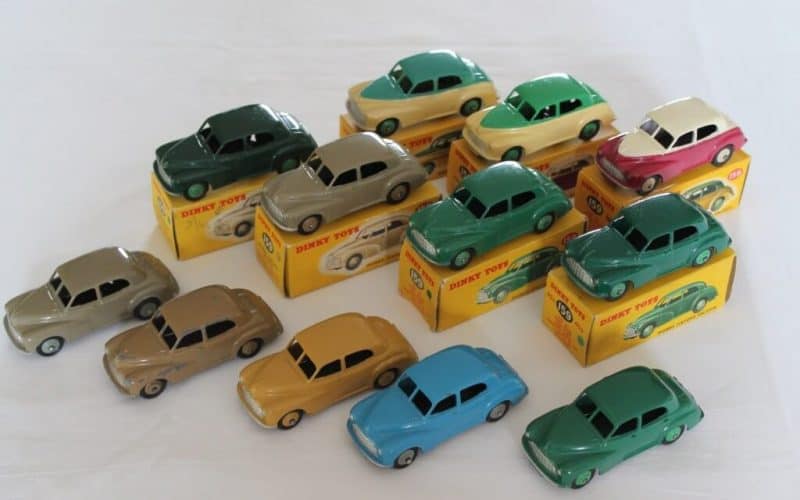
Introduction
The Dinky model version of the Morris Oxford was based on the original Morris Oxford MO produced between 1948 to 1954. There were two versions of the original car, both were four seater, the saloon and the traveller estate car.
Around 160,000 units were produced and this was followed by the Morris Oxford series 2, which Corgi modelled their early release on.
It was designed by Alec Issigonis who also designed the smaller version and very popular Morris Minor.
A Morris Oxford panel van was also issued during this production period.
Casting & Base Plate
The model casting changed only once during its lifetime. Early models had no description on the underside of the roof, whereas the later models and all two tone models had ‘Morris Oxford’ cast to the underside of the roof. The base plate I believe was never changed and always had the small writing style cast.
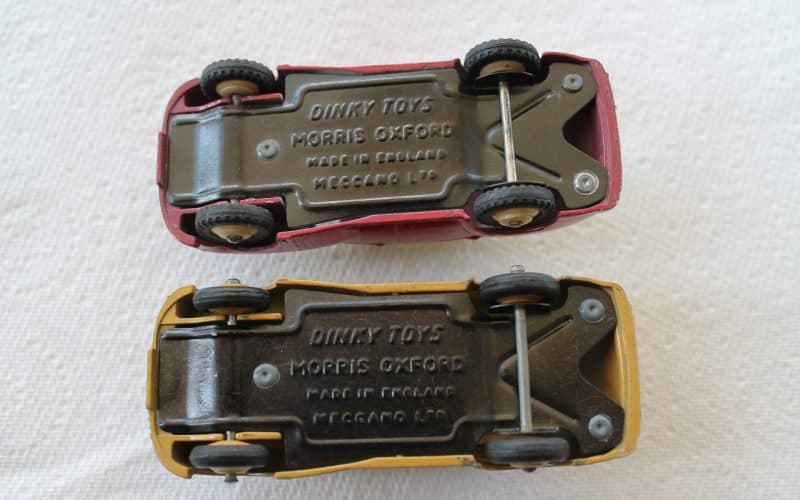
Tyres
The tyres were the black smooth type.
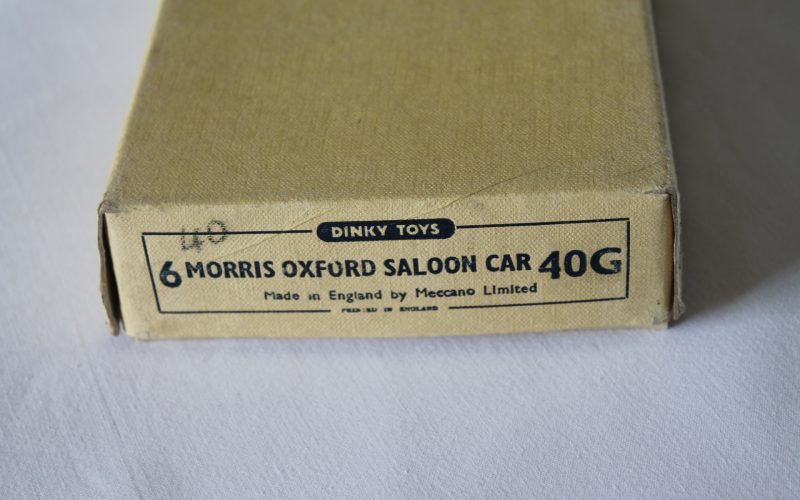
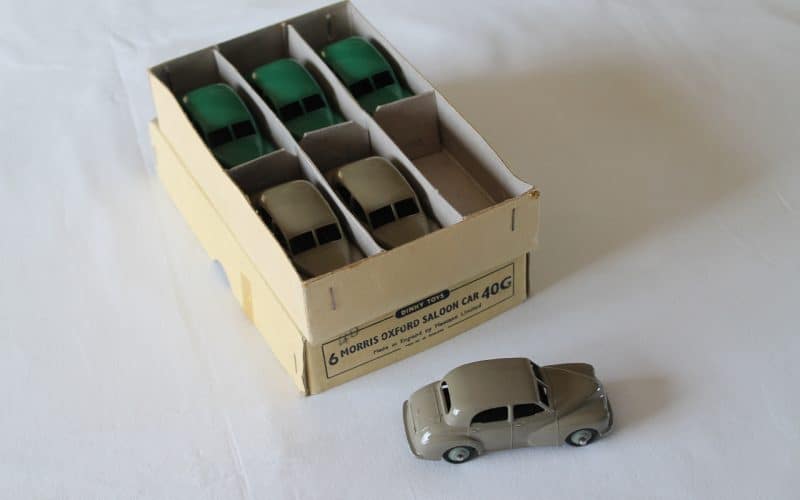
Box Packing. Trade Boxes.
The early packing of these models was provided in trade boxes of six to the shop keeper and these came in several designs. A type 2 trade box which was the first release post war had a brown box with yellow label applied to the end with model description, but this trade box I have never seen used for the ’40g’. The type 3 & 5 trade boxes were used but also, as previously mentioned, a cream-lighter yellow trade box with printed end description marked ’40g’. From my own observations the most likely trade box to be seen is a type 3 marked ’40g’ in yellow printed card
I have not observed a type 4 box which has the added six digit code above the description, but the type 5 variation I have seen with the dual numbering being ‘159’ to the left side and the ‘40g’ to the right of each end.
Individual Box.
There were three designs used.
The first box, and the hardest to find, is a dual numbered box with no ovals or numbers on the picture sides. At the ends are black ovals with white numbering ‘159’ and the early code of ’40g’ in red to either side of the black oval. An all green model is on one side mushroom/stone model with matching wheels on the other. I have seen and also have a box with a green spot applied. I am not sure if this was done for the alternative colours.
The second box style was similar with the model colours to the picture sides and as type 1. Also to each picture side were red ovals with white ‘159’ numbering. The end flaps were similar generally but now the earlier numbering of ‘40g’ is omitted. Secondly an applied printed colour spot displayed the model colour expected within.
The third and final design showed the two standard colour designs for the new two tone models. This was a green and cream model one side and a cerise and white model the other. The printing was the same as the type two box, other than the attractive split two tone colour spot to the end flaps.

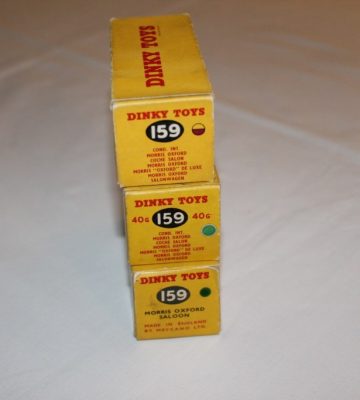
Models.
Type 1 models that I have found with no writing on the underside of the roof are listed first and would have each been sold through an early trade box not likely to have been an individual box. These are as follows;
- Tan with matching tan wheels
- Blue with grey wheels
- Stone with grey wheels
- Dark green with green wheels
- Green with matching wheels

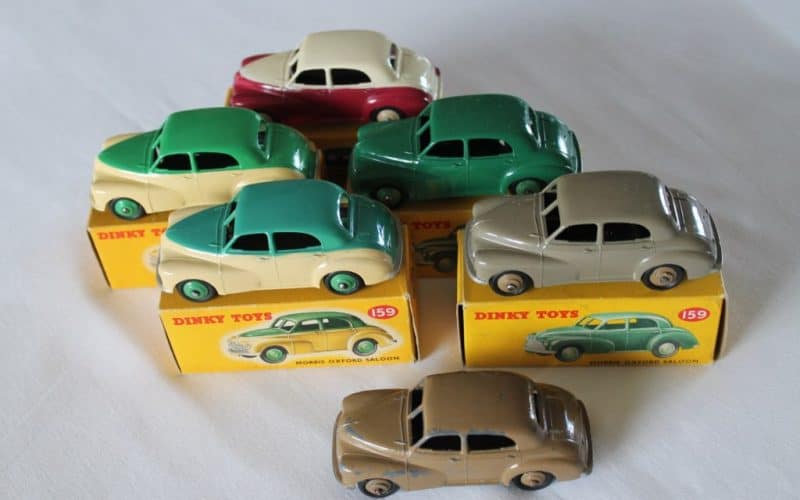
Type 2 models likely to have been issued around 1953-54 and onwards and found with the model name cast underside of the roof follow. These models would have been individually boxed.
- Various shades of green ‘but not dark green’ with green wheels
- Stone with beige wheels
- Beige with matching wheels
- Green & cream with green wheels
- Blue-green & cream with green
- Cerise & white-cream with beige wheels
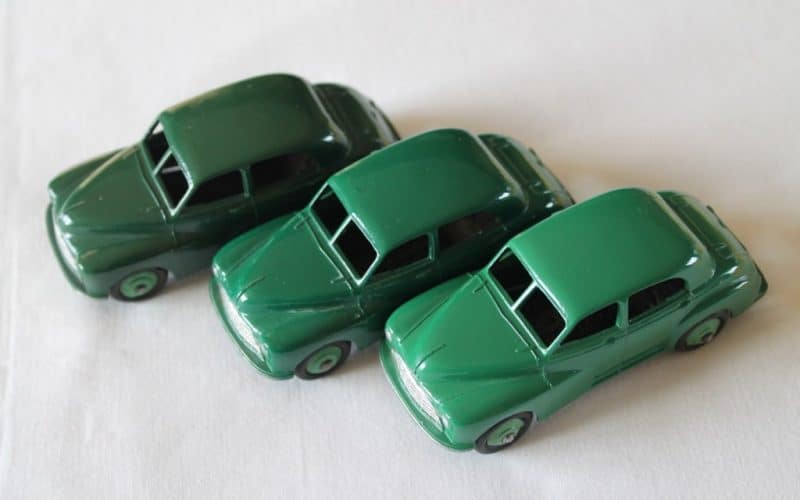
Sales and Valuation.
This is not an easy model to accurately categorise.
Points to note;
- There are various shades of mid green that exist but I have grouped as one.
- The all over beige is difficult to tell when studying pictures of sold models but I believe this is a very scarce and un-observed colour variation. I have a poor condition example only.
- Dark green models are scarce. From my own observations these would certainly have come in trade boxes but also may have come in dual numbered individual boxes with green spots applied.
- Tan models are rare but the blue variation is very rare and one of the most sought after model cars of this decade amongst enthusiasts.
The total sales reflect all models sold whether boxed or unboxed, whether individual or six units from a trade box. Certain assumptions have been made when in a trade box, if there is no view of the wheels and finally all conditions, whether mint or play worn have been used. All shades of mid green with green wheels are grouped as one.
I have utilised two additional business sources including an auction house and another direct retailer of collectables as well as my own business to create these examples of sales reflected over a latest ten year period.
Sales to February 2019.
The total unit of sales recorded for this survey since August 2000 are 471 models. The distribution is as follows:
Sales of 40g/159 models
- 1 Blue with grey wheels
- 4 Tan with tan wheels
- 14 Dark green with green wheels
- 1 Beige with beige wheels
- 1 Mushroom-grey with green wheels
- 90 Mushroom-grey with grey wheels
- 37 Mushroom-grey with beige wheels
- 132 Green (various shades) and green wheels
- 105 Green & Cream two tone with green wheels
- 0 Blue-Green & Cream two tone with green wheels
- 83 Cerise & Cream two tone with light beige wheels
Gift set No 3 Passenger Cars 1952-54
This gift set was launched with six vehicles. Three were from the 40 series of cars including the 40g Morris Oxford which would always be a green model with green wheels. I have a record of eight of these sets sold all with a green model. The total sales recorded for this survey since September 2010 are 468 models.
Conclusions.
The early models were without doubt the ones found with no description under the roof.
Certainly from my own stock and observations, you can say that the mushroom grey with grey wheels was the early release and came in trade boxes. The similar shade model but with beige wheels was later and would generally come in its own box.
The rare beige with beige wheels which I have an example of, be it in poor condition, was a later issue.
The blue-green shade is rare. I have seen three in total but I also have a 156 two tone green Rover 75 with a similar blue-green shade.
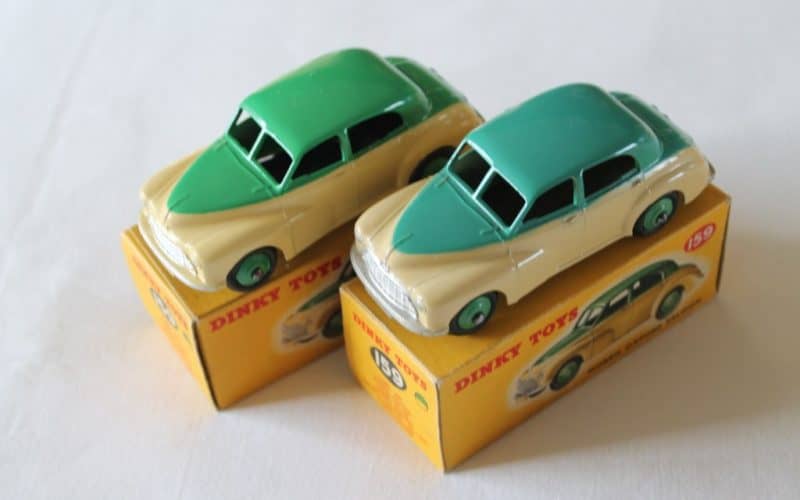
If you are aware of any genuine variations not listed above please feel free to email me with details and pictures and I will always consider adding to the above article or following up with another.
Model Value.
Below is a guide to the value of a mint model in my own opinion.
Type 1 40g models cast with no underside roof description, unboxed;
Blue with grey wheels £2000-£2500
Tan with tan wheels £1000-£1500
Dark green with green wheels £350-£450
Mushroom-grey with grey wheels £80-£120
Various green shades with green wheels £80-£120


Type 2 base with ‘Morris Oxford’ cast under the roof, boxed.
Various green shades with green wheels £150-£225
Mushroom-grey with beige wheels £200-£275
Beige with beige wheels NGPP
Green & Cream two tone with green wheels £250-£325
Blue-Green & Cream two tone with green wheels £500-£600
Cerise & Cream two tone with light beige wheels £300-£450
Note.
The price guide is for Mint models and boxes for type 2 only. A premium may be expected for clearly different shades of green. I have an example, which is as near to a dark green model as to a mid green model, as illustrated.
I hope you have enjoyed this article. Any comments you may have are gratefully received.